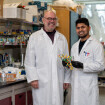-
 Enterococcus faecalis bacteria. Credit: Wikimedia Commons
Enterococcus faecalis bacteria. Credit: Wikimedia Commons -
 Associate Professor of Medicine Dr. Daria Van Tyne, University of Pittsburgh, Division of Infectious Diseases. Credit: Pitt U
Associate Professor of Medicine Dr. Daria Van Tyne, University of Pittsburgh, Division of Infectious Diseases. Credit: Pitt U -
 Lead author Emma Mills, microbiology and immunology graduate student at University of Pittsburgh, Division of Infectious Diseases. Credit: Pitt U
Lead author Emma Mills, microbiology and immunology graduate student at University of Pittsburgh, Division of Infectious Diseases. Credit: Pitt U
Research news
Parade of pathogens: antimicrobials produced by drug-resistant bacteria kills competitors
Apr 08 2025
A drug-resistant bacteria – vancomycin-resistant Enterococcus faecium (VREfm) – has recently been found to weaponise an antimicrobial genetic tool to eliminate its bacterial cousins and establish itself as the dominate strain.
A team from University of Pittsburgh School of Medicine (UPMC) made the discovery when analysing local hospital infection data from Pittsburgh, Pennsylvania, but then went on to confirm it was a global phenomenon.
The researchers developed an analytic method alongside the University of Pittsburgh (Pitt) and UPMC which deployed genomic sequencing alongside computer algorithms in order to rapidly detect infectious disease outbreaks. The findings have the potential to underpin development of novel therapeutics against some of the deadliest bacteria.
“Our lab has a front row seat to the parade of pathogens that move through the hospital setting,” said senior author Dr. Daria Van Tyne, associate professor of medicine in Pitt’s Division of Infectious Diseases.
“And when we took a step back and zoomed out, it quickly became apparent that big changes were afoot with VREfm, one of the world’s more difficult-to-treat bacteria.”
Antibacterial compound found: McMaster team discovers wholly new class of antibiotics
The last time a new class of antibiotics reached the market was almost three decades ago – but that could soon change, thanks to a discovery by researchers at McMaster University, Hamilton, Ont... Read More
The Enhanced Detection System for Healthcare-Associated Transmission (EDS-HAT) analyses the genetic signatures of infections in hospitalised patients and searches for patterns which it flags to allow clinicians to intervene and halt potential outbreaks in real-time.
However, lead author Emma Mills, a microbiology and immunology graduate student in Van Tyne’s lab, realised that EDS-HAT was also a treasure trove of detailed historic information that she could mine to learn about the evolution of bacteria over time.
Mills focused on VREfm, so-called because it can’t be eradicated with the antibiotic vancomycin – a glycopeptide antibiotic – and considered to be one of the strongest available. VREfm kills about 40% of the people it infects and is a particular risk to immunocompromised and hospitalised patients.
Upon analysis of the genomic sequences of 710 VREfm infection samples from hospitalised patients which had been added to the EDS-HAT across a six-year period, Mills discovered that the variety of VREfm strains had collapsed. In 2017 there were around types which showed even distribution but by 2018 two dominant strains began to emerge which by the end of 2022, were accounting for 80% of patient VREfm samples.
Closer examination showed that the dominant strains had become able to produce a bacteriocin – an antimicrobial used by bacteria to kill or inhibit one another – and had weaponised this capability to destroy other VREfm strains, so improving access to nutrients for better reproduction.
Mills’s explored the possibility that this was a global phenomenon, by consulting a publicly available library of more than 15,000 VREfm genomes collected globally between 2002 and 2022 to discover that what had been observed locally was also happening on a global scale.
“This was a completely unexpected discovery – I was surprised to see such a dramatic signal,” said Mills.
“Once these strains are in an institutional setting – such as a hospital – and are matched up against other strains of VRE in a patient’s gut, they take over. It’s a ‘kill your buddies and eat their food’ scenario.”
Van Tyne said the finding doesn’t have immediate clinical consequences – it does not appear that the bacteriocin-wielding VREfm are making patients any sicker than their predecessors did. But it could point to potential avenues for the development of new therapies.
“The diversity of the VRE population appears to be narrowing from lots of different types causing infection to only a few. That means we may soon have only one single target for which to design therapeutics such as antibiotics or phage therapy,” Van Tyne said.
“It also suggests that bacteriocins are very potent and perhaps we could [deploy] them for our own purposes,” she concluded.
For further reading please visit: 10.1038/s41564-025-01958-0
Digital Edition
Lab Asia Dec 2025
December 2025
Chromatography Articles- Cutting-edge sample preparation tools help laboratories to stay ahead of the curveMass Spectrometry & Spectroscopy Articles- Unlocking the complexity of metabolomics: Pushi...
View all digital editions
Events
Jan 21 2026 Tokyo, Japan
Jan 28 2026 Tokyo, Japan
Jan 29 2026 New Delhi, India
Feb 07 2026 Boston, MA, USA
Asia Pharma Expo/Asia Lab Expo
Feb 12 2026 Dhaka, Bangladesh



















